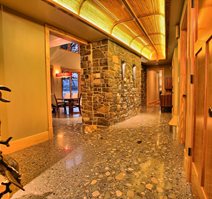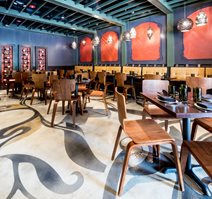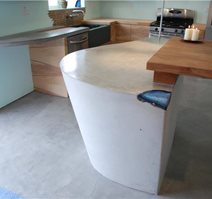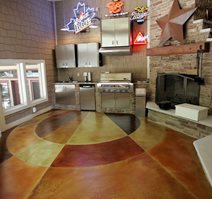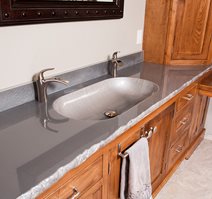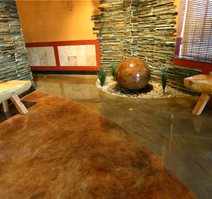- Staining Concrete
- Stamped Concrete
- Concrete Overlays
- Concrete Resurfacing
- Concrete Polishing
- Concrete Dyes
- Colored Concrete
- Indoor Concrete
- Concrete Floors
- Concrete Countertops
- Garage Floor Coatings
- Furniture, Sinks, Fire Bowls
- Basement Floors
- Outdoor Concrete
- Concrete Patios
- Concrete Driveways
- Concrete Pool Decks
- Outdoor Kitchens & Counters
- Outdoor Fireplace
- Concrete Walkways
- Concrete Pavers
- Concrete Walls
- Repair & Maintenance
- Foundation Repair
- Concrete Crack Repair
- Concrete Sealers
- Building with Concrete
- Concrete Homes
- Concrete Basements
- Decorative Concrete
6 Interior Design Trends Perfectly Suited for Concrete
Ideas for incorporating decorative concrete into the latest decorating trendsAre you planning to revamp the interior of your home or business and wondering how you can use concrete to reflect today’s design trends? Macala Wright, a writer and marketing professional interested in culture and design, recently released her interior design predictions for 2016. We were struck by how easily decorative concrete fit into her list. In fact, we think the decorative concrete industry actually inspired a few of these trends. Read on to discover how concrete can be used to make Wright’s predictions a reality in your own space.
Bring the Outdoors In
The boundaries between the indoors and outdoors are quickly vanishing, as more interior designers use strategies to make the transition between the two areas virtually seamless. Concrete is one of the few materials that can be used both indoors and out, and the color pallet and design can be inspired by elements found in the surrounding landscape, such as a riverbed, the ocean, or a botanical theme. See these examples:
Make Splash with Water-Inspired Concrete Floors
Floral-Inspired Floor Art
Embossed Tree Wall Creates a Nature-Themed Tub Surround
Add Artisan Flair
More designers are discovering that decorative concrete is anything but cookie-cutter. It’s the perfect material for anyone who wants to express their artistic tastes, whether through color, pattern, shape or special inlays. Many decorative concrete contractors excel at taking a blank canvas (plain concrete) and using different coloring mediums, tools and techniques to transform it into custom artwork. Here are some of our favorite works of “artisan” concrete, all inspired by the owner’s vision:
Concrete Countertops Become an Artists Canvas
Concrete Floor Inspired by a Wall in Venice
Stenciled Concrete Floor Adds Grecian Flair to Upscale Restaurant
Minerals Are In
The use of natural minerals as interior accents, such as chunks of quartz and semi-precious stones, is on the upswing according to Wright, as more designers embrace the “recycling, repurposing, and reusing” craze. For years, concrete countertop makers have been casting natural stones and geodes in their slabs and then revealing their beauty by polishing. Often these stones are found on the surrounding property or supplied by the homeowner to add a personal touch to their countertops. Other popular natural embeds for concrete countertops include seashells, petrified wood, and pieces of quartz. Check out these projects:
Fluid Geometry
Wright says that consumers are gravitating towards geometric patterns that feature fluid movement. Few materials surpass concrete when it comes to fluidity, whether in shape, pattern or design. With concrete floors, for example, you can use decorative sawcuts and various stain colors to create unique free-form geometric patterns (see Stained Concrete Floor Sawing and Patterning). Concrete tiles for floors and walls also offer geometric versatility by allowing you to include cutouts and embeds, imprinted patterns, three-dimensional sculptural designs, and more. Check out our concrete tile photo gallery.
Mix Metallics and Metals
Brass, gold and metallic finishes are all the rage right now and those same finishes can easily be applied to concrete floors and other surfaces. Metallic coatings for concrete floors have been popular in high-end retail and commercial spaces for several years and are now beginning to capture the attention of homeowners who want to replicate the same upscale, modern look (see Metallic Coating FAQs). Metallic finishes are also showstoppers when applied to concrete sinks and countertops. See this project: Metallic Finish Enhances a Concrete Sink.
Make It Sustainable
We’ve long touted the sustainability of concrete as one of its greatest attributes. It uses natural materials, it’s long lasting, and it can be recycled and repurposed - all the characteristics today’s interior designers look for when choosing materials. What’s more, concrete has an organic look and feel that appeals to the environmentally conscious. Decorative concrete can also be used to score points for LEED green building certification. Learn more.
